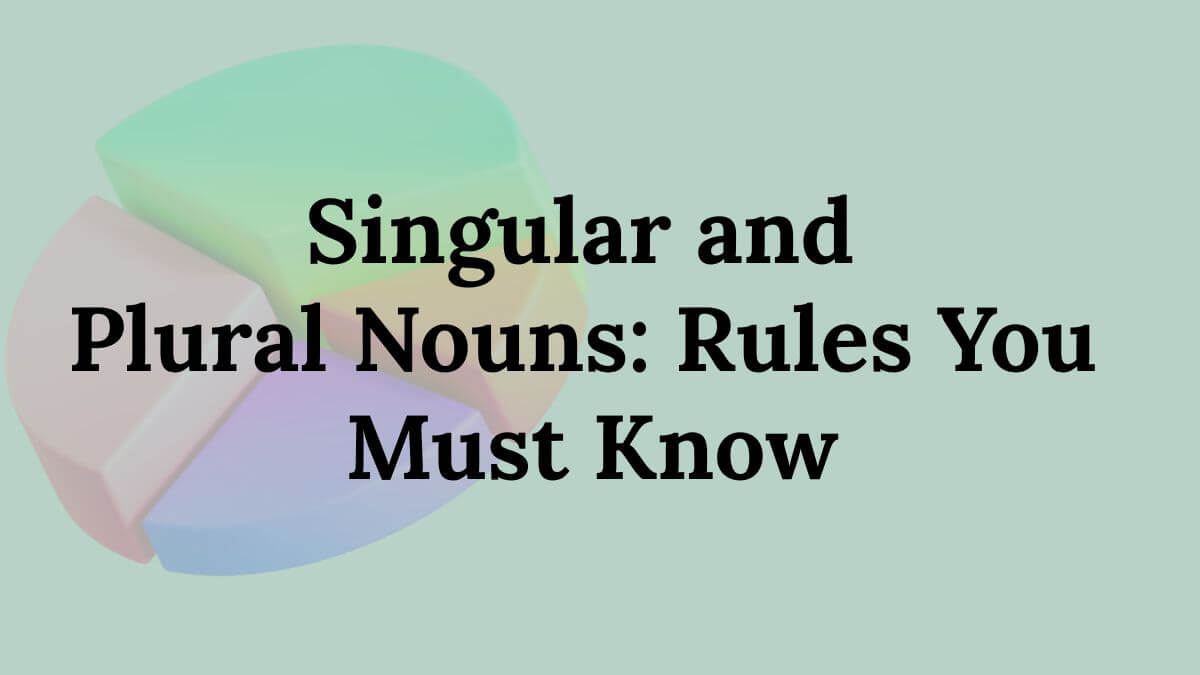Understanding the difference between singular and plural nouns is one of the most important grammar rules for English learners. Whether you’re writing an essay, speaking fluently, or teaching English, mastering singular and plural nouns will greatly improve your communication skills. In this post, we’ll explore the essential rules, exceptions, and examples you must know to confidently use nouns in bot forms.
Why Learning Singular and Plural Nouns Matt
hers,
Nouns are the building blocks of language—they give names to everything we see, feel, think, or imagine. When we refer to just one or something, we use the singular form. When referring to more than one, we switch to the plural form to show quantity or number. While this might sound simple, there are many exceptions and special rules in English.
- By mastering singular and plural nouns, you’ll unlock the power to express ideas with precision, clarity, and confidence in any context.
- Speak and write more clearly
- Avoid common grammar mistakes
- Build a strong foundation for advanced English grammar
- Teach others more effectively if you’re an educator
Let’s explore the essential rules that will make using singular and plural nouns second nature.
Basic Rule: Add -s to Make a Plural
The simplest and most common way to make a noun plural is by adding -s to the end of the word.
Examples:
- Book → Books
- Car → Cars
- Dog → Dogs
This rule applies to most nouns in English. However, there are some spelling rules and exceptions that you must remember.
To keep the sound smooth, add -es to nouns ending in -s, -sh, -ch, -x, or -z when making them plural. If a noun ends in -s, -sh, -ch, -x, or -z, you typically add -es instead of just -s.
Examples:
- Box → Boxes
- Brush → Brushes
- Watch → Watches
- Quiz → Quizzes
Nouns Ending in -y: Watch the Letter Before Y
There are two important rules for nouns that end in -y:
If a vowel comes before -y in a noun, just add -s to form the plural—no spelling change needed!
City → Cities
Baby → Babies
- Toy → Toys
- Key → Keys
Nouns Ending in -o: Sometimes -s, Sometimes -es
This is a tricky area. Some nouns ending in -o simply take -s, while others need -es. Unfortunately, there isn’t always a perfect rule, so some memorization is needed.
Add -es:
- Tomato → Tomatoes
- Hero → Heroes
Add -s:
- Piano → Pianos
- Photo → Photos
- Nouns Ending in -f or -fe: Change to -ves
For many nouns ending in -f or -fe, the plural is formed by changing the ending to -ves.
Examples:
- Leaf → Leaves
- Knife → Knives
- Wife → Wives
However, some just add -s instead:
- Roof → Roofs
- Belief → Beliefs
It’s best to memorize the most common ones.
Irregular Plural Nouns
Some English nouns do not follow any standard rule when they become plural. These are called irregular plural nouns.
Examples:
- Man → Men
- Woman → Women
- Child → Children
- Mouse → Mice
- Tooth → Teeth
- Foot → Feet
Same Singular and Plural Form
Some nouns remain unchanged and look the same whether they’re singular or plural. These are often names of animals, objects, or foreign words.
Examples:
- Sheep → Sheep
- Deer → Deer
- Fish → Fish (though “fishes” is used when referring to different species)
Other examples include:
- Aircraft → Aircraft
- Species → Species
Uncountable Nouns Stay Singular
Uncountable nouns represent things that can’t be counted as separate units; they typically don’t have a plural form and are paired with singular verbs.
Examples:
- Information
- Water
- Advice
- Furniture
- Money
Plurals with Numbers and Quantifiers
When you use numbers, words like many, few, or several, make sure the noun is plural. Singular and Plural Nouns
Examples:
- Three apples
- Many books
- A few minutes
But use singular with words like each, every, or one:
- Every student
- One car
- Each idea
Latin and Greek Plural Forms
Some English words come from Latin or Greek and keep their original plural forms. Singular and Plural Nouns
Examples:
- Radius → Radii
- Curriculum → Curricula
- Cactus → Cacti
- Thesis → Theses
Read More:
Top 10 Rules for Using Nouns in English for beginner
10 Simple English Dialogues for Beginners: Grow Your Speaking Skills
Conclusion
Mastering singular and plural nouns is a key step in improving your English grammar. By learning the basic rules and common exceptions, you can speak and write more accurately and confidently. Keep practicing, and these rules will soon become second nature! Singular and Plural Nouns
